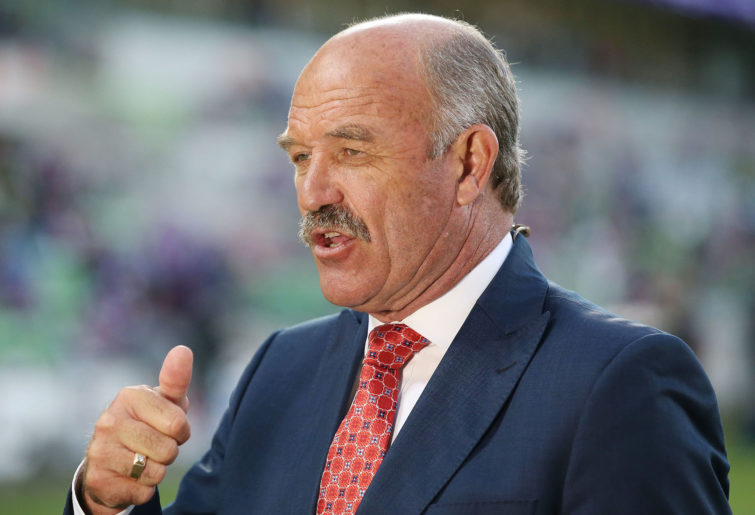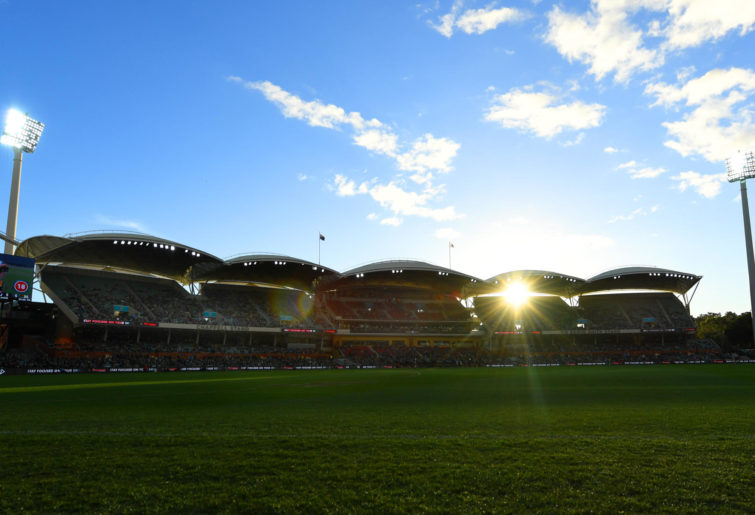This the fifth article in the series where we’ll have a look at the 17 rugby league clubs that have come and gone in the last 113 years.
Who were they, what happened to them, who were their best players, what legacy did they leave behind, and what did they achieve?
With so many defunct teams to get through, we’ll work through them in the chronological order in which they departed the competition.
In Parts 1 to 4 we looked at the nine clubs that disappeared from view up to 1997. Today we’ll look at the Gold Coast and Adelaide, two clubs that exited the competition in 1998.
Gold Coast Giants/Seagulls/Gladiators/Chargers
Gold Coast entered the competition in 1988 and departed at the end of 1998.
When it comes to the Gold Coast, it’s complicated, and we’re really talking about three and a bit incarnations of the one club that competed across the competitions run by the NSWRL, the ARL and finally the NRL.

(Photo by Getty Images)
First came the Gold Coast-Tweed Giants, who were part of the NSWRL’s expansion push in 1988 that saw three clubs being added to the competition, with both Newcastle and Brisbane joining the Giants in the big time.
The club was virtually formed on the rebound by the syndicate that lost the Brisbane bid, and they had to play out of Tweed Heads rather than anywhere north of the river due to restrictions attached to the Broncos successful bid.
They assembled a few big names together to give the club some instant credibility, with Bob McCarthy appointed as coach and Graeme Langlands as team manager, and signed well known players in Chris Close, Billy Johnstone, Ron Gibbs, Neil Hunt and Mike Eden as the backbone of their inaugural squad.
The on-field highlights in their first season were few and far between though, and they finished second last with just four wins and two draws from 22 rounds, but they did have the satisfaction of defeating both fellow newcomers, accounting for Brisbane 25-22 and Newcastle 9-0.
1989 saw both the arrival of Queensland legend Bob Lindner and a marginally better result, as the Giants took a baby step up the ladder to finish 14th with seven wins and a draw, including an 8-4 victory over eventual semi-finalists in Cronulla.
1990 then saw the club morph into the Gold Coast Seagulls, complete with a flash new black, red and white strip but still playing out of Tweed Heads, but things didn’t look much brighter on the field, and they dropped back to second last on the ladder after registering just four wins, two of which were against wooden spooners South Sydney.
1990 also saw the departure of both inaugural coach Bob McCarthy, who was replaced by the experienced Malcolm Clift, and inaugural captain Billy Johnstone, who retired at the end of the season.
1991 was a strange season for the Gold Coast. They signed the greatest living Queenslander in Wally Lewis to captain the side.

(Photo by Michael Dodge/Getty Images)
He was joined by English international centre Daryl Powell, the ‘Black Flash’ Larry Corowa made a two-game comeback after seven years out of the game, and the Seagulls finished with the wooden spoon after registering just two wins and a draw.
1992 saw King Wally take over as captain coach, making him the last of the captain/coaches in the modern era, together with the arrival of some big name reinforcements in Brent Todd, Steve Jackson and Dale Shearer.
But it was all to no avail, as the club finished with its second wooden spoon. Lewis retired from his playing role at the end of the year but fatefully continued on as coach.
The 1993 season was a low point for the struggling club as it took the spoon for the third year running, after registering just a single victory during the year and finishing with a points differential of -343.
Things weren’t any better off the field as the club received a $50,000 fine for a salary cap breach the previous year, several senior players left the club, and coach Wally Lewis resigned at year end after ongoing conflict with the club’s management.
1994 and 1995 saw more of the same under new coach John Harvey, and the Seagulls finished 15th out of 16 in 1994 with five wins and a draw, and 17th out of 20 in 1995 with four wins and a draw.
Some key players left the club at the end of 1995, while the sustained disappointing results led to decreasing crowds, and Super League was looming large.
After eight years of throwing cash into a ravenous money pit, the Seagulls Leagues Club finally came to their senses and withdrew their financial support, and it looked like the Gold Coast was doomed.
Enter a white knight, complete with white shoes, in the form of local entrepreneur Jeff Muller, who acquired the football club’s license.
Muller renamed the club the Gold Coast Gladiators, gave them a new playing strip, a flash new logo, appointed Phil Economides as coach, and relocated the club’s home ground across the border to Carrara Stadium.
Happy days, however the ARL proceeded to revoke Muller’s license, and in an effort to maintain a presence on the Gold Coast, transitioned to yet another identity for the team, the Gold Coast Chargers.
The club was funded by the ARL and controlled by a board they appointed. The ARL also appointed well known rugby league administrator Paul Broughton as chief executive.
Only three players from the Seagulls’ 1995 squad made the transition to the Chargers in 1996, and with just weeks to spare before the start of the 1996 competition, they hurriedly put together a squad including NZ international Dave Watson, Martin Bella, Jeff Orford, and Lee Oudenryn.
They began the season well, winning three games from their first six, but then fell away to finish 18th out of 20, with just five wins and a draw for the season. Familiar territory.
1997 saw the arrival of Super League, and the resultant split in the competition, and the Chargers were part the ARL’s 12-team competition.
They put in their best effort yet that year, winning ten games and drawing one, and finishing just inside the top seven, ready for their first ever finals appearance.
They defeated Illawarra 25-14 in the minor semi-final but went down to the Sydney City Roosters 32-10 a week later in the major qualifying semi-final. Still, it was a great year for the club, and coach Phil Economides was named coach of the year.
1998 saw the end of Super League and the beginning of the NRL and its 20-team competition. The Hunter Mariners were one of the Super League teams excluded from the new competition, and in what proved to be a fateful decision, the Chargers spurned an offer from the Mariners, who were battling for some sort of survival.

(Photo by Phil Walter/Getty Images)
Under terms of the Mariners’ offer, the Chargers could have had first pick of the Mariners’ squad and receive a $5 million grant, provided that the Mariners’ chief executive and some staff were also taken on by the Chargers.
The plan was rejected, and instead of being picked up by the Chargers, the new Melbourne Storm club acquired the services of ex-Mariners Scott Hill, Paul Marquet, Brett Kimmorley, John Carlaw and Richard Swain. What could have been.
Instead, the Chargers had one of their worst seasons ever, winning just four of 24 games, conceding 654 points, and finishing just above Western Suburbs in second last place on points differential.
In a familiar story, the Chargers’ lack of success, poor management and infighting saw the club disbanded at the end of 1998.
Some Gold Coast fun facts:
• Halfback Jamie Goddard played most games for the club with 86.
• Lock forward Brendan Hurst scored most points for the club with 285.
• Outside back Danny Peacock scored most tries with 28.
Adelaide Rams
Adelaide entered the competition in 1997 and departed at the end of 1998.
The Adelaide Rams’ story is as simple as the Gold Coast’s is complicated. The Rams were a child of the Super League, and together with the Hunter Mariners, were formed to take part in SL’s inaugural ten-team competition in 1997. In a sense, SL beat the ARL to the punch with Adelaide as it had long been on their expansion radar.
1997 saw St George legend Rod Reddy installed as coach and former Queensland and Australian representative Kerrod Walters appointed captain. Apart from Walters, they didn’t recruit any marquee players, with players of the calibre of Kurt Wrigley, Cameron Blair, Alan Cann, Rod Maybon, Kevin Campion and Luke Williamson seeing the most game time in their first season.
Their home ground in 1997 was the picturesque Adelaide Oval, and there’s no doubting that interest in rugby league was high in Adelaide, and the Rams drew an average of 15,300 fans to their home games.

The Rams played out of Adelaide Oval throughout their brief existence. (Photo by Mark Brake/Getty Images)
Unfortunately, they didn’t have the talent to make much of a noise on the field, winning just seven games and drawing one across the 18 rounds, and finished in second last place, just shading North Queensland by a point.
Fast forward to 1998 and the Rams now found themselves as one of the 20 teams in the newly constituted NRL competition. They inexplicably cut hard man and Queensland representative Kevin Campion from their squad and their only notable signings for the year were winger Matt Daylight from the Reds, outside back Graham Appo from Canberra, plus half Noel Goldthorpe and Kiwi Tony Iro from the Mariners.
The Rams started the 1998 season badly, winning just one game from the first ten rounds. At this point Rod Reddy and his entire coaching team were shown the door and Dean Lance was appointed coach.
Lance had some immediate success and the Rams won six of their next ten matches, before falling in heap towards the end of the season, losing their last four games. They finished in 17th place on the ladder, ahead of Souths, Gold Coast and Wests, and average home attendances fell by 50 per cent.
The NRL originally planned to continue with the 20-team competition in 1999 and then decrease it to 14 teams in 2000, and Adelaide were keen to continue on, however the merger of St George and Illawarra at the end of 1998 resulted in a further review of the competition’s direction.
At the 11th hour, News Ltd then withdrew their financial support and the club was wound up just days after their 1999 season launch.
Some Adelaide fun facts:
• Their biggest win was 52-0 over Balmain in Round 17 of 1998 when centre Graham Appo notched up a personal tally of 22 points.
• Captain Kerrod Walters holds the record for most games for the club with 41.
• Graham Appo holds the records for most points and most tries for the club, with 116 points and 12 tries respectively.
• Michael ‘Madge’ Maguire played fullback in Adelaide’s first game, which was also the first game played in the Super League competition.
Well, that’s it from me for the year. Thanks for reading and for your comments.
Have a happy and safe Christmas and I’ll finish this series of articles in 2022.
































































































